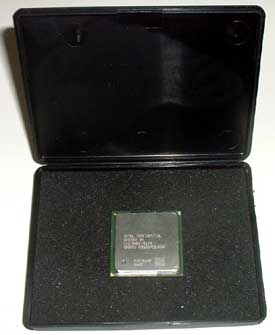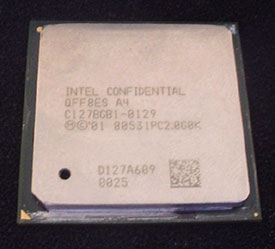
| Summary : |
![]()
Methodology of test:
Intel-platform, Synchronous mode
As you already know, the QDR bus of the Pentium IV uses a 100MHz frequency and transfers its data with 4-bits in each cycle. In this way the Intel Pentium IV is able to obtain a 400Mbit/S data-throughput. Under these circumstances, obtaining a frequency of 200MHz equals an 800MHz QDR bus! Which is absolutely impossible to realize with today's hardware… But unlike the EV6 bus used on the Athlon XP, with its 100MHz frequency handling a 200MHz memory, here the Intel Pentium IV allows us to obtain a very well balanced system. With 100MHz QDR we can easily handle a 200MHz DDR based system, and the desynchronisation of the FSB and the memory takes all the benefit here. But of course as we like to test everything to the bottom, we tested both methods: the asynchronous and the synchronous. Let's take a look at it:
Like we explained in the AMD-platform part, obtaining an 200MHz FSB on
a CPU built to run at 100MHz represents a 100% overclock. And such an
overclock is almost impossible to realize. Except of course if you can
reduce the multiplication coefficient like we did on the Athlon MP. But
actually Intel restricted those features and is currently not offering
any CPU with a changeable coefficient. This Intel-policy puts us in some
trouble, which makes it more difficult to demonstrate the superiority
of Intel CPU, and compromising the tests at 200MHz bus. Fortunately, some
very rare CPUs, the so-called " ES " (Engineering Sample), or
" Intel Confidential " allow to adjust that famous coefficient.
Those CPUs, only available in pre-production, are designated either to
Intel engineers or to large manufacturers to allow them to proceed the
first tests with those new CPUs, just right before everybody launches
their mass-production. It won't be that difficult to understand that,
since those CPUs are extremely rare, Intel reserve these exquisite CPUs
for internal use only… But after lobbying a little bit we managed
to obtain an official Pentium IV " ES " 2 GHz:
 |
 |
This Pentium IV 2 GHz "Intel Confidential" offers like all other similar CPUs the big advantage to allow free choice of Multiplication Coefficient. Unfortunately the Intel-policy on these CPUs is extremely restricted. The delay of one week will not allow us to proceed any tests, because at the moment we received that CPU the DDR400 didn't arrive. So the only thing we could do with this CPU was play a little bit, but without the Kingmax DDR400 this "Intel Confidential" was totally useless. A few days after we had to return the "Intel Confidential" we received the DDR400 modules from Kingmax… So we had to source for the second time this extremely rare CPU. Once again an "Intel Confidential", but this time to proceed advanced tests. Finally a large PC-manufacturer (which prefers to stay anonymous in order to maintain his privileged relation with Intel) accepted to let us use their Intel Pentium IV ES, under the explicit condition that all of the tests had to be done in their own laboratory. Therefore we took our motherboard and all other material and we went to the manufacturer to proceed the tests.
Here are all the elements:
Most important was of course the motherboard. For test purposes we used
an Abit BD7 based on Intel i845D

We qualified this motherboard because of its PLL and BIOS, which allowed us to maintain the PCI frequency at a user determined fixed value. This way we didn't had to consider anymore the PCI frequency before increasing the FSB frequency (knowing the BIOS allows a maximum of 250MHz). After a few specific settings where done we put our Artic Silver 3 paste on the NorthBridge. Without any difficulty we obtained a frequency of 10x200MHz in other terms 2GHz. Unfortunately due to the specific circumstances in which we were forced to realize this test, we couldn't take our traditional pictures with the Digital Camera, so we have to be satisfied with Screen Shots realized with Cpu-Z which was developed by Franck :

In other terms, compared with the problems we experienced on the AMD, Intel allowed us to obtain the 200MHz FSB without any difficulty. But we have to specify that the 200MHz FSB in synchronous mode is impossible to realize without having an " Engineering Sample ". We only realized these synchronous mode tests in order to verify if the Kingmax DDR400 were able to run stable under these extremely aggressive test conditions, which really asks much more performance from the module than what's required in asynchronous mode. This brings us into the user accessible part of our tests, the asynchronous mode on next page.
Next ( Methodology of test: Intel-platform, Asynchronous mode )